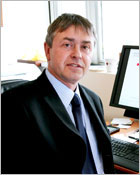2012
World Cancer Day 2012. Together it is possible
04/02/2012 –

Dr Wild, could you tell us how, in your view, “Together it is possible”? mp3
I think this phrase ‘together it’s possible’ really emphasizes to me how essential it is to work together towards a common goal in relation to
understanding the causes of cancer and its prevention. And this particularly came home to me recently, when I attended the United Nations’ General Assembly in New York last September,
when the Assembly really addressed the growing problem of cancer and other chronic diseases in the low- and middle-income countries. It is very clear that in order to address this problem,
it is going to have to be a cooperation across different government departments for example in relation to the risk that obesity poses for cancer. Then one has to think not only of the health
sector but also the environment, transport and so on. It is also true that ‘together, it’s possible’ indicates a cooperation not only within government but also across other organizations and
I think it is evident that there is a role for international organizations to play such as IARC but also non government organizations and also the private sector and it is really that cooperation
across each of these areas that is going to make a difference in the long term.
I think that in terms of the Agency itself when we think about ‘together it is possible’, it is really in relation to collaborative research and research is our major focus and increasingly what we
are finding in the cancer research area is that we need larger studies, often multicentre studies cooperations at an international level, in order to answer the critical questions that are important
to the national level. So, in a sense we need international studies to answer national questions and from its very inception IARC’s mission has been to promote collaboration. Not only collaboration
in the sense of studies across countries but also across disciplines. We need to bring together the skills of epidemiology and laboratory science, biostatistics, social sciences increasingly in order
to answer the types of questions that are important to provide an evidence-base for cancer prevention.
I think one of the great advantages of IARC in this respect is its position as part of the WHO. This gives us a very good opportunity to present our own research in the latest research internationally and integrate that
into WHO’s advice on cancer control. Not only that, but the fact that we have our own collaborations with different countries means that people are aware of the Agency’s research and can use that in
decision-making. Having that close link to WHO and to governments really illustrates where the gaps are in knowledge for cancer prevention and this then informs some of the priorities that we set for
our own research. Perhaps a couple of examples are interesting there: one, certainly around the vaccination against human papillomavirus where we are trying to understand whether 2 or 3 doses are
necessary to provide protection of young girls against eventually cervical cancer risk. Also we are aware that in respect to breast cancer for example, national screening programmes using mammography
are not always applicable in particularly low-resource settings. So we are trying to conduct research that will show whether clinical breast examination or breast awareness amongst women will also contribute
to a reduced risk of cancer. So this type of research is really aimed at translating the findings into recommendations and policy at the earliest possible level. I think perhaps just to add that we are still
searching for the causes of many cancers and trying to understand the risks associated with exposures and there, the IARC Monographs Programme where we bring together international experts to evaluate the
evidence that something is linked to a cancer risk, is also very helpful.
What struck me most over the last two to three years is the increasing awareness, particularly in low- and middle-income countries, of the growing burden of cancer. And in responding to that awareness, the Agency certainly has a number of approaches which we can take. The first is to better describe
the burden of cancer in those regions by strengthening cancer registries. The second one is to continue to collaborate internationally, to try and identify risk factors, and that’s often necessary in order to get studies which are large enough to detect smaller risks associated with a given exposure.
I think the other thing is the interdisciplinary research really trying to get the different disciplines to work together cooperatively to answer these questions about the causes and prevention of cancer. And also, given the economic climate that we are facing with very limited resources for research
in each individual country, there is an onus on us as scientists to find ways to cooperate to address common questions of importance to prioritize the research and to work together in such a way that we don’t duplicate our efforts or indeed omit to address certain important questions. I think that
implicit within them is the necessity for collaboration, cooperation and that really is the theme of this UICC initiated World Cancer Day of ‘Together, it is possible’. I firmly believe that is true being based in an international organization which has collaboration and cooperation at its heart then
we are fully committed to this approach.
